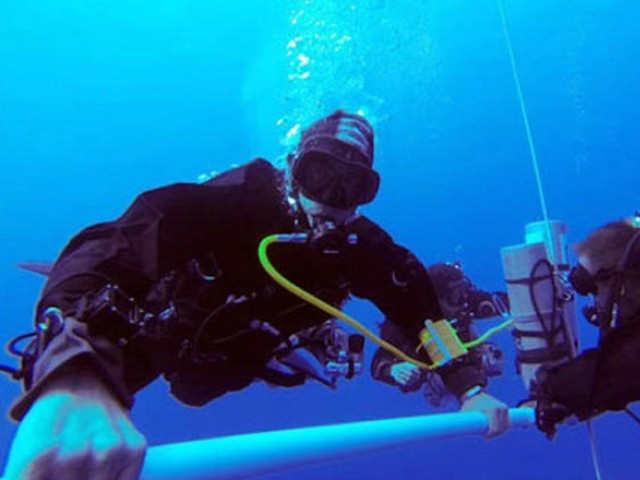He resurfaced victorious, 14 hours after he submerged, and was met by a representative from Guinness World Records. Gabr’s astonishing descent took him to 1,090 feet (332.35 meters), beating by 46 feet (14.1 meters) the existing world record, which was set by South African Nuno Gomes in 2005. Gabr, like Gomes, completed his deep dive in an underwater abyss in the Red Sea near Dahab. His record-breaking dream began there four years ago, but plans to challenge Gomes’ title were put on hold due to political instability in Egypt and Gabr’s role as an officer in the Egyptian army. Despite these initial difficulties, Gabr resumed training in earnest when the political situation stabilized somewhat.
Because of the risks involved in ultra-deep diving, Gabr faced rigorous training for the dive, including perfecting yoga techniques designed to slow his heart rate and limit his breathing at depth. There was also a team of doctors present on the boat during his attempt. Most importantly, though, Gabr’s preparations included countless training dives on both air and trimix, some of them as deep as 720 feet (220 meters). Because even the slightest problem can have severe ramifications at depth, Gabr and his team also simulated various emergencies, ensuring that they had a contingency plan for any eventuality. The dangers involved in ultra-deep diving have been proven many times over; in 1994, for example, American diver Sheck Exley tragically died while attempting to set a new record in the Mexican cenotes.
Complications from nitrogen narcosis, decompression illness and equipment malfunctions are all exacerbated when they occur at depth. Deep divers also run the risk of High-Pressure Nervous Syndrome (HPNS), which occurs as a result of using helium past 492 feet (150 meters). Symptoms of HPNS include tremors, drowsiness, decreased mental capacity, nausea and dizziness, all of which can lead to fatal errors underwater. A team of 30 volunteers, each of whom brought specific skills, experience or knowledge to the effort, helped ensure Gabr’s safety. Some acted as surface support, others as logistics managers or in-water support divers, while still others helped raise the funds necessary for the expensive gas mixes required for both the training dives and the attempt itself. In the end, Gabr and his in-water team used over 100 cylinders to complete the final dive. Gabr entered the water with nine tanks, which would have enabled him to reach 1,148 feet (350 meters) — his initial goal — and return to 361 feet (110 meters), where he met his first support diver, who gave him another tank. Although Gabr was shooting for 350 meters, at 332.35 meters he was suffering from the effects of HPNS, and with the record already broken, he knew it was time to turn back.
Amazingly, Gabr’s descent only took 12 minutes; his ascent, and all the necessary decompression stages, occupied the rest of the 14-hour dive. Support divers accompanied him until he reached the 50-meter mark (164 feet), after which he carried on alone. On his way, he secured tags affixed to a line to prove that he had reached each depth, a compulsory measure so that Guinness World Records would officially recognize his effort. Out of the 14-hour total, Gabr was only alone for about 40 minutes, and after the dive, he recounted how he had been kept company for six hours by a juvenile oceanic whitetip shark. Gabr reportedly surfaced from his successful attempt feeling “unbelievable,” understandable, given the scope of his achievement. In 2005, French diver Pascal Bernabe challenged Nuno Gomes’ record by claiming to have reached 1,082 feet (330 meters), but Guinness World Records never accepted the dive due to insufficient evidence. By exceeding Bernabe’s claimed depth by 2.35 meters, Gabr has become the uncontested king of deep diving.
Gabr first learned to dive in 1994 at age 18 and became an instructor two years later. He served in various branches of the Egyptian military while building up his diving experience and abilities until eventually he was accepted into the U.S. Army Combat Diver Qualification Course. Now retired from the military, Gabr is an experienced TDI Instructor Trainer with H20 Divers Dahab.


